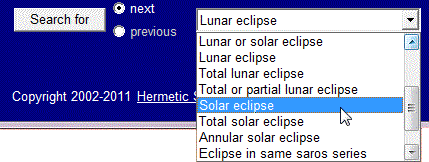|
 As a second example of an eclipse search, consider the eclipse which occurred over Europe on 1999-08-11 CE. Set the time to GMT. Enter "1999-08-10 CE" (one day before) in the Date/time window and click on Convert. Then select next solar eclipse and click on Search to obtain:
As a second example of an eclipse search, consider the eclipse which occurred over Europe on 1999-08-11 CE. Set the time to GMT. Enter "1999-08-10 CE" (one day before) in the Date/time window and click on Convert. Then select next solar eclipse and click on Search to obtain:

| Search for next solar eclipse. 1999-08-11 CE 11:03 (Greenwich; local = GMT) ARC=4697-06-29 MP=102-25-06-01 LLT=098-05-01-1 MMG=1-94-03-30 HLW=4999-05-4-7 Dark moon, illum. = 0.0%, lunat. and age = [-6] 29 days, 8 hrs, 39 mins (100.0%). Central total solar eclipse, lunation number = -5, saros number = 145. Search for next dark moon. 1999-08-11 CE 11:08 (Greenwich; local = GMT) ARC=4697-06-29 MP=102-25-06-01 LLT=098-05-01-1 MMG=1-94-03-30 HLW=4999-05-4-7 Dark moon, illum. = 0.0%, lunat. and age = [-5] 0 days, 0 hrs, 0 mins (0.0%). |
| Contents | Introduction |
| Hermetic Systems Home Page | |